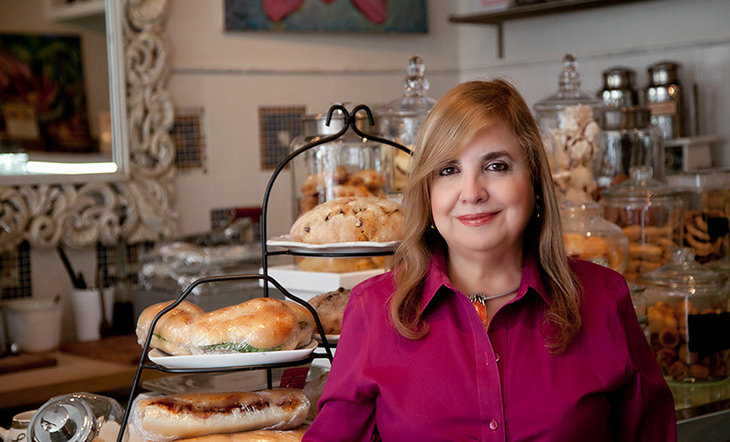When Searching for Flavor, Go to the Source
"Libre de Sent Sovi," the cookbook that changed my life
Maricel Presilla, as told to Gabriella GershensonNovember 14, 2019

When we talk about the potential of American cooking, we don't just mean what's being served in restaurants around the country. Home cooking plays just as big a role in our ever-evolving food culture, and those who devote themselves to educating and celebrating the domestic kitchen deserve a turn in the spotlight for their efforts. In this series, we're featuring James Beard Award–winning cookbook authors and exploring the books that most influenced the way they cook, eat, and write.
The second installment features chef, restaurateur, and Latin-American cooking authority Maricel Presilla. She received the 2013 James Beard Cookbook of the Year Award for her definitive cookbook, Gran Cocina Latina: The Food of Latin America (W.W. Norton & Company, 2012), won the 2012 Best Chef: Mid-Atlantic Award for the cooking at her Hoboken, New Jersey restaurant Cucharamama, and in 2015 was inducted into the Who's Who of Food & Beverage in America. She tells us about the cookbook that most informs her work, a fourteenth-century Catalan text called Libre de Sent Sovi, transcribed in 1979 by Rudolf Grewe.
--
When I revisit key sections of my book Gran Cocina Latina, it is clear to me that I often relied on very old recipe collections or chronicles written in medieval and renaissance Spain, or in the early colonial period in the Americas. One source that is recurrent is a fourteenth-century Catalan recipe book called Libre de Sent Sovi (Book of Sent Sovi), which contains recipes that the conquistadors took to the Americas. When you look at the recipes in this book, you realize where particular Latin American dishes found their inspiration.
For me, checking Libre de Sent Sovi is an instinctive act. I use the Catalan transcription done in 1979 by my late friend Rudolf Grewe, who lived in New York and guided me through the book and the original manuscripts. He was a bibliophile. When I’d go to his apartment, I’d have to step over tons of books, facsimile editions, first editions…it was incredible. There are now new English and French translations of Libre de Sent Sovi, but I still use Rudolf’s edition. To say that this book is my bible is an understatement: I consult it every time I am going to research an old Latin-American recipe. The recipes are good—not only can you actually read them, but I’ve cooked from them, too.
In Gran Cocina Latina, I have a very important section, called the “Layers of Latin Flavor,” which I think is my favorite. Gran Cocina Latina is a book of foundations, and when I talk about the foundations of Latin cooking, I start with the first layer of flavor, called adobo, which is a marinade. The second layer is the sofrito, the cooking sauce. We have this type of cooking sauce in many guises, with many different names. But it starts essentially with pan-frying Mediterranean ingredients—onions and garlic. Then, in the Americas, tomatoes came into the sofrito. And then peppers. A more Spanish-inspired recipe for sofrito would have sausages, like chorizo, or bacon. Then you might add spices according to where you came from. If you are from Ecuador, you add a lot of cumin. If you're in Cuba, you might add oregano, pulsed with cumin. In my hometown in Cuba, we added allspice.
In Latin America, you had native populations everywhere. Then you had the Spanish coming to some places, like Cuba, and wiping out a lot of the native population. In other areas, they were mixing with it. But the framework—the backbone—of most things in Latin America is Iberian. A diffusion happened in the early colonial period through institutions such as convents, where Iberian cooking techniques merged with Native American techniques and ingredients. You get richer versions of everything that was cooked in Spain, and you have ingredients of the land being added to the sofrito, like spicy peppers.
In Libre de Sent Sovi, you clearly see the origins of Latin American dishes. Sofrito, for instance, is the descendant of the Iberian sofregit. That foundational recipe is key to so many of our dishes. We start stew with sofrito. We make certain flavored rices with sofrito. We add it to soups. It's just instinctive to flavor a dish starting with sofrito. It's so basic. It really is one of those incredible tools that Latin American and Spanish cooks have.
There are rules to making a good sofrito. You don't rush it. You work in stages. If you know anything about Indian cooking, you know that you don't throw all the spices in the pot. It's the same thing here. I have rules when I make sofrito. I never rush it. Why? Because if you rush it, what you end up with is steamed onions and garlic.
So that I get a lot of flavor, when I make a sofrito, I cook down everything until the fat, usually olive oil, begins to be released from the solids, and you see the frying again. The moment of truth is when you see that oil oozing out and the whole thing frying again. That's when I stop. A good cook knows how to do it.
Make Maricel's recipe for Veracruz tomato sauce.
The 30th anniversary of the James Beard Awards is coming up next year. Learn more about the Awards.
--
Gabriella Gershenson is a James Beard Award–nominated food journalist based in New York City. Follower her on Instagram and Twitter @gabiwrites.



-57 web.jpg)


